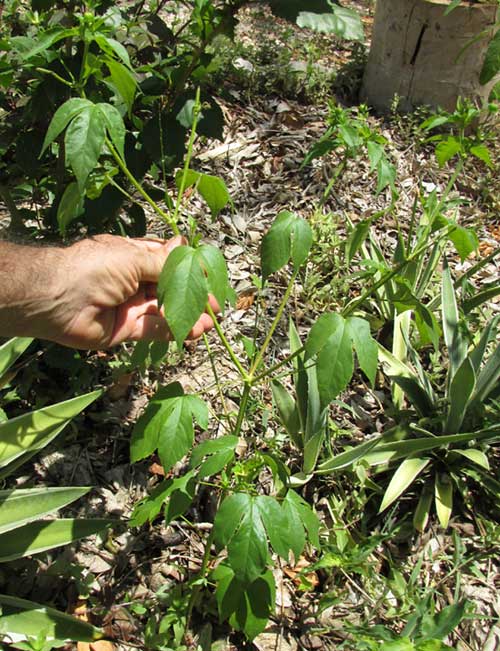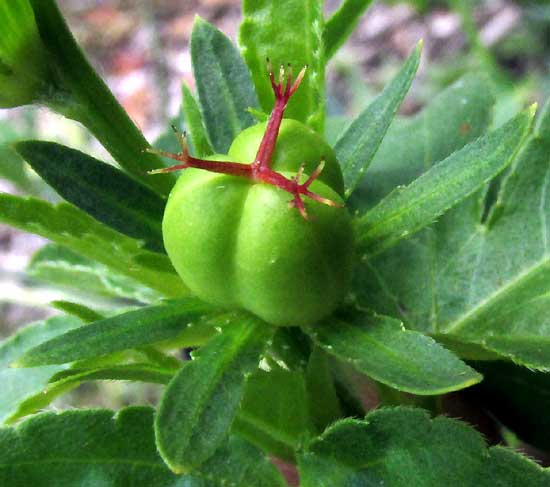Excerpts from Jim Conrad's
Naturalist Newsletter
from the June 5, 2016 Newsletter issued from Hacienda Chichen Resort beside Chichén Itzá Ruins; limestone bedrock; elevation ~39m (~128ft), N20.675°, W88.569°; central Yucatán state, MÉXICO
LOBED CROTON
Several weeks ago when next to the hut a seedling appeared beside some agaves I was watering, I didn't pull it up, because I wanting to see what it would grow into. Now the plant is about knee high and below you can see its distinctive three-lobed leaves:

That's a mature plant that has been producing both male and female flowers for two or three weeks. The tiny male flowers consist of five reddish-maroon sepals, five pale yellowish corolla lobes, and several stamens, as shown below:

The thumbnail-size female flowers are more eye-catching, consisting of flaring sepals, no corolla, and a green, three-lobed ovary topped with three maroon styles deeply and doubly forked at their tips, as shown below:

Whenever you have a leafy plant with unisexual flowers and the ovaries three-lobed, first you need to think of the big Euphorbia or Spurge Family, the Euphorbiacea. Within the Euphorbiaceae there's a genus producing many herbs, bushes and small trees with flowers and fruits just like these, and that's the genus Croton, of which we've identified several species here. Our most recent Croton encountered was the "Tree Croton," whose vegetative parts were very different from our present plant's, though its flowers were strikingly similar, as you can confirm at www.backyardnature.net/mexnat/croton2.htm
Usually it's hard to figure out which of the many croton species you have, but this time the three-lobed leaves are so un-croton-like that getting the name was easy. My front-yard weed is the Lobed Croton, CROTON LOBATUS, and that binomial is a good old Linnaeus one, published in his venerable Species Plantarum 2 in 1753.
One reason that Lobed Croton has an English Name is that it's native to most of the tropical and subtropical Americas, plus it's invasive in much of the rest of the world's tropics, especially in Africa and the Arabian Peninsula. In Africa it's regarded as a very useful plant, which isn't surprising because members of the Euphorbia Family are famous for the powerful, often toxic and/or medicinal, compounds in their sap.
For example, in Ivory Coast, arrow poison is made from Lobed Croton. The plant is crushed between stones with a little water, the arrows are dipped in the resulting paste, and folks regard the paste as the best arrow poison around.
On the other hand, elsewhere leaves boiled in water provide an enema for gynecological problems, and mixed with palm-oil, its leaf paste is rubbed onto sores caused by guinea-worm. Other uses range from helping headaches, whooping-cough and malaria, and for scorpion stings. In some places it's an aphrodisiac. Against witchcraft, just wash yourself with a lotion of it.
Mexicans, however, don't seem too impressed with its medicinal value. Mostly they think of it as a weed in their cornfields and plantations.